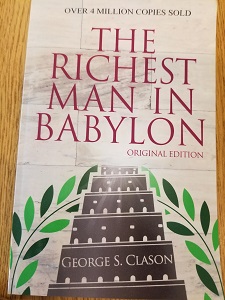The Clay Tablets From Babylon: The Richest Man in Babylon, Pt. 8 of 9

Photo credit: jb
This article is Part Eight in our series of the lessons from George S. Clason’s bestseller The Richest Man in Babylon. If you’d like to go back to the beginning and catch up on the earlier lessons, you can start with the first article in the series by clicking this link.
The Clay Tablets From Babylon
This chapter* is fancifully comprised of several letters back and forth between an archeologist, digging up the ruins of old Babylon, and his colleague at St. Swithin’s College of Nottingham University. (Imagine a scene from one of the Indiana Jones movies…) The subject of the letters is a collection of clay tablets that the archeologist has had delivered to the college – supposedly the record of our old friend Dabasir’s financial affairs. If you don’t recall, Dabasir was introduced to us in the previous chapter, The Camel Trader of Babylon. In that lesson, we learned that having the right attitude can take you where you want to go in life. In these clay tablets, we find the details of how Dabasir worked his way out of debt.
In the letters, the professor at St. Swithin’s is telling his colleague the archeologist that the details written on the clay tablets has opened his eyes to a new way to deal with his own financial affairs… and then in a subsequent letter he explains that the formula used by old Dabasir has, in fact changed his life.
Here is the lesson: If you find yourself dealing with a debt situation that is out of control, the only way to “fix” it is to organize your information and begin attacking the problem. Old Dabasir details on the clay tablets how he used the first rule, saving one-tenth of all his earnings, to begin building up his savings. Then, he made a list of all of his creditors, including the amounts owed. He took this opportunity to visit each creditor, explaining that he could not currently pay off the debt completely, but that he was undertaking to gradually pay off all of his creditors. He took his list of debts to show them, and explained to each that this debt would be serviced by two-tenths of his earnings, each debt in proportion.
Some of his creditors rebuked him – saying they needed all of the money returned immediately. Others were happy to hear that he was working his way out of debt. In the end, none of the creditors had any choice but to accept his offer – which he attended to religiously. Each time he earned some money, one-tenth went into his savings, two-tenths was split among his creditors evenly, and the remaining seven-tenths he and his wife used for food, clothing, and other needs.
The surprising thing, to both Dabasir and later the professor at St. Swithin’s, was that getting along on 70% of his earnings was not as difficult as he thought it would be. Soon enough, in both cases, the debts were disappearing, and the savings were accumulating. In due time, both men retired all of their debts, had increased savings, and had learned to live on much less than they earned. These are keys to financial success.
There’s no magic to it – but for some reason those particular proportions work well and provide success to anyone who undertakes such a plan. Very important to the success of this plan is to write down your debts, and to talk to your creditors to explain your plan. Don’t skip this step, as you’ll either cause problems for yourself when the creditors don’t understand, or you’ll underestimate the size of your debt. Writing it down will put you in a position to track your progress as you begin retiring the debt, as well – which can be very helpful to keep you motivated through the process. Sticking to the plan – having discipline to carry it out – is all that remains for you to succeed.
Three facets – Organization, Efficiency and Discipline – are used to resolve this problem. Organizing your debt information so that both you and your creditors understand it. Efficiency is necessary to manager your own life on only 70% of your earnings. And Discipline is required to maintain the payoff schedule, as well as the savings activity, throughout good times and bad.
One more chapter awaits, this one called “The Luckiest Man in Babylon” – and it brings many of the lessons together in one concise place.
*Note: in my current copy of the book, this interplay with the archeologist and the colleague is not included, but only the actual information from the tablets, along with Dabasir’s narrative. I left the original (to me) description intact as it helps to explain and drive home the point of the message.
The post The Clay Tablets From Babylon: The Richest Man in Babylon, Pt. 8 of 9 appeared first on Getting Your Financial Ducks In A Row.
source https://financialducksinarow.com/1458/the-clay-tablets-from-babylon-the-richest-man-in-babylon-pt-8/
Comments
Post a Comment